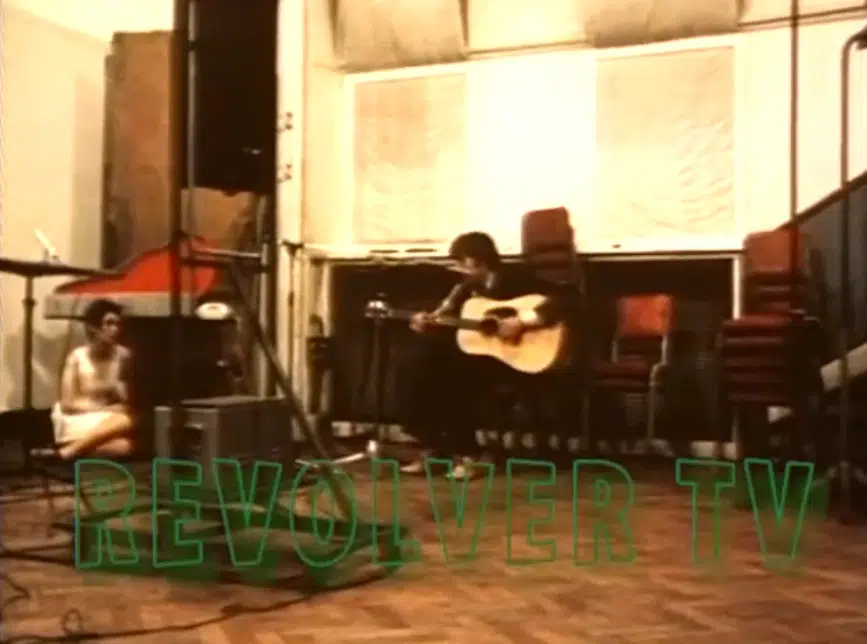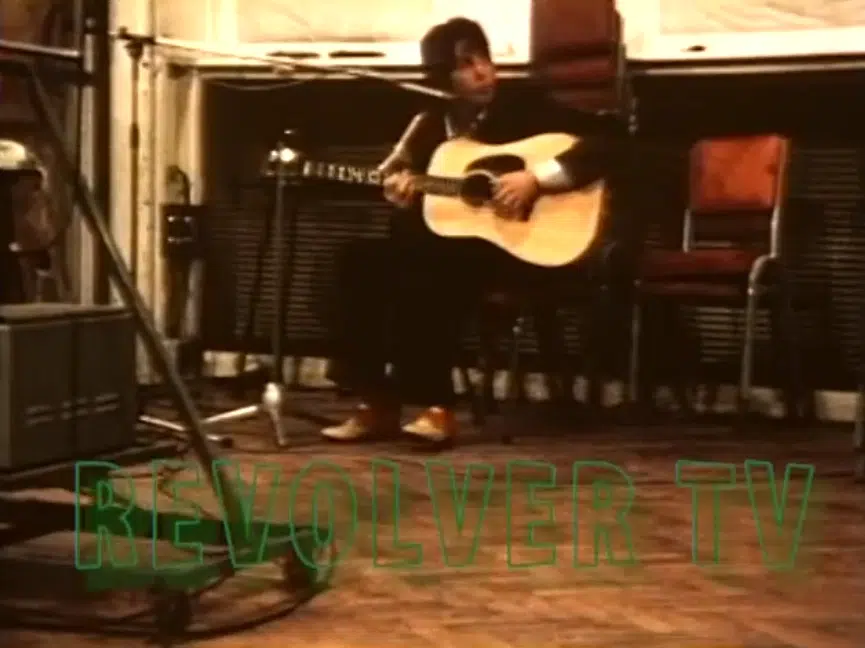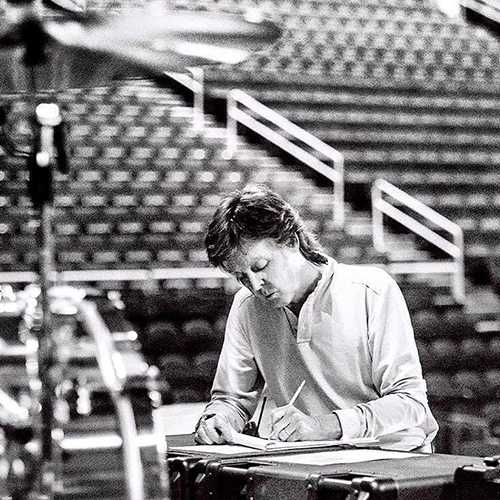Tuesday, June 11, 1968
Recording "Blackbird", "Revolution 9"
For The Beatles
Last updated on October 16, 2024
Tuesday, June 11, 1968
For The Beatles
Last updated on October 16, 2024
"The Beatles" (aka the White Album) sessions
May 30 - Oct 18, 1968 • Songs recorded during this session appear on The Beatles (Mono)
Recording studio: EMI Studios, Studio Two, Abbey Road
Recording studio: EMI Studios, Studio Three, Abbey Road
Interview Jun 09, 1968 • The Beatles interview for BBC Radio 1
Session Jun 10, 1968 • Recording "Revolution 9"
Session Jun 11, 1968 • Recording "Blackbird", "Revolution 9"
Interview Jun 12, 1968 • The Beatles interview for The Daily Mirror
Article Jun 18, 1968 • Paul McCartney celebrates his 26th birthday
Next session Jun 20, 1968 • Recording "Revolution 9"
AlbumSome of the songs worked on during this session were first released on the "The Beatles (Mono)" LP
From June 7 to June 18, 1968, George Harrison and Ringo Starr were both in the USA. The sessions for the White Album continued with John Lennon and Paul McCartney.
The Beatles – who clearly didn’t like being in one another’s company anymore – were able to split up into small groups, working simultaneously in two or even all three of the studios in the Abbey Road complex. This soon became standard operating procedure for much of the rest of the ‘White Album.’ It was as if the four band members were so much in separate spaces personally, they wanted to make their record in separate spaces physically. On those evenings, I would normally work with Paul, because I had the best rapport with him. Another engineer would accompany John or George Harrison, with the taciturn (and rarely consulted) Ringo shuttling between studios as he was needed. That was the situation on the night that we worked on Paul’s first contribution to the album, the poignant ballad ‘Blackbird.’
Neither Ringo nor George was present on that particular evening, and John wanted to begin compiling sound effects for what would ultimately become ‘Revolution 9,’ so as soon as he learned that another studio was available (at 7 pm), he decided to head off with (producer) Chris Thomas and Phil (McDonald) – accompanied, as usual, by Yoko. That left George Martin and me alone with Paul, which came as a blessed relief to me after all the stress of the preceding sessions; it always was a lot easier to deal with one Beatle.
Geoff Emerick – From “Here, There and Everywhere: My Life Recording the Music of The Beatles“, 2006
On this day, John Lennon continued working on sound effects to be used on “Revolution 9” in Abbey Road Studio Three. Meanwhile, in Studio Two, Paul McCartney started and finished the recording of “Blackbird” in a single session. The performance was a solo act with McCartney strumming a Martin D-28 acoustic guitar. Only three sounds were recorded: Paul’s vocals, his guitar, and rhythmic tapping on the left audio channel. This tapping was previously misidentified as a metronome, but engineer Geoff Emerick clarified that it was actually Paul tapping his foot — a detail Paul himself confirmed in The Beatles’ Anthology documentary. Emerick remembers that the foot-tapping was recorded with a separate microphone.
Playing his left-handed acoustic guitar, Paul began running the song down, and I loved it immediately. Perfectionist that he was, he performed it over and over again, trying to get the complicated guitar part right all the way through. At one point a cameraman appeared to do a little filming for an Apple promo, and that interrupted the flow a little bit, but Paul just carried on, with his new lady friend [Francie Schwartz] sitting cross-legged at his feet. Paul had recently broken up with Jane Asher, and that might have been another reason why he was so subdued during the ‘White Album’ sessions…I suppose it’s possible that Paul invited the girl along as an answer to John bringing in Yoko. But in contrast to Yoko, she didn’t stay long, and George Martin had to leave early, too.
Geoff Emerick – From “Here, There and Everywhere: My Life Recording the Music of The Beatles“, 2006
At some point during the recording of “Blackbird“, John, Paul and George Martin were present together. John joined Paul on acoustic guitar and also piano, and the three discussed the idea of adding an arrangement to the song:
You see, the only thing is that immediately I start to arrange it, I imagine a string quartet after the second verse.
Paul McCartney – from “The Beatles” super deluxe book, 2018
There should be an arranged sound coming from a distance – a fairly complicated one like a bit of decoration that you’ve got on the back of a painting… it suddenly comes up and as it comes up close, you start again.
George Martin – from “The Beatles” super deluxe book, 2018
John Lennon then suggested that a “very nice little bit of brass band” could be added, to which Paul agreed saying “yes, that would be lovely“. He then played a version of “Mother Nature’s Son” on acoustic guitar, remarking “that would be nice with a brass band…like four…cornet, euphonium…little“. In the end, no embellishment was added on “Blackbird“, but some would be added on “Mother Nature’s Son” on August 20.
A total of 32 takes of “Blackbird” were recorded, with only 11 being complete. Take 32 was deemed the best. Paul then double-tracked his vocals on certain sections of the song, leading to the creation of six mono mixes. The final mono and stereo mixes were done on October 13.
After [the film crew – see below had] gone, Paul remarked to me that he wanted the track to sound as if he was singing it outdoors. ‘Fine,’ I said, ‘then let’s do it outdoors.’ He looked surprised, but there was a little spot outside of the echo chamber with just enough room for him to sit on a stool. I ran a long mic lead out there and that’s where we recorded ‘Blackbird.’ Most of the bird noises were dubbed on later, from a sound effects record, but a couple of them were live, sparrows and finches singing outside the Abbey Road studio on a soft summer eve along with Paul McCartney.
Geoff Emerick – From “Here, There and Everywhere: My Life Recording the Music of The Beatles“, 2006
“Anthology 3” includes take 23 (mislabelled as take 4), and “The Beatles” 2018 boxset includes take 28.
Recorded by Paul alone – as indeed was the White Album master version – this is Take 4 of Blackbird, an unadorned acoustic guitar and vocal performance that captured well the essence of his new song, and may even have been usable at the time were it not for unwanted background noises. The completed “best” recording of Blackbird was Take 32, with the verse/chorus order revised and a second acoustic guitar track and bird song effects added before the end of this session.
From the Anthology 3 liner notes
The session, which began at 6:30 pm, ended at 12:15 pm.
During the session, a film crew directed by Tony Bramwell was present in the studio to shoot a promotional film for Apple Records. Multiple sequences were captured that day. In some sequences, we observe rehearsals of Paul McCartney performing “Blackbird” and “Helter Skelter.” In another sequence, Paul is seen alongside Mary Hopkin, a newly signed artist to Apple, as they listen to a playback of her latest recordings.
This film was presented at the Capitol Records Convention in Los Angeles on June 21, 1968.
The film we came up with was a little bit arty and airy-fairy. There was a sequence of James Taylor and Mary Hopkin and Paul doing ‘Blackbird’, which I had filmed in early June; unshown footage that the BBC had banned of The Beatles doing ‘A Day In The Life’ from Sgt Pepper; a bit about the new Apple shop; some footage on the wildly experimental Indica Art Gallery and finally, The Beatles having a business meeting with ‘Uncle’ Dick James in the new Apple offices in Wigmore Street. John Lennon insisted on including footage of Magic Alex in his habitual white coat, fiddling with a pile of junk. Overall, it was a pretty little film when it was finished and everyone said how well they thought it would go down. Ron Kass said it would be a very useful tool to show the record executives at the Capitol convention in LA what Apple was all about.
Tony Bramwell – From “Magical Mystery Tours: My Life with the Beatles“, 2005




Recording • Take 1
Recording • Take 2
Recording • Take 3
Recording • Take 4
Recording • Take 5
Recording • Take 6
Recording • Take 7
Recording • Take 8
Recording • Take 9
Recording • Take 10
Recording • Take 11
Recording • Take 12
Recording • Take 13
Recording • Take 14
Recording • Take 15
Recording • Take 16
Recording • Take 17
Recording • Take 18
Recording • Take 19
Recording • Take 20
Recording • Take 21
Recording • Take 22
Recording • Take 23
AlbumOfficially released on Anthology 3
Recording • Take 24
Recording • Take 25
Recording • Take 26
Recording • Take 27
Recording • Take 28
AlbumOfficially released on The Beatles (50th anniversary boxset)
Recording • Take 29
Recording • Take 30
Recording • Take 31
Recording • Take 32
Recording • SI on Take 32
Mixing • Mono mixing - Remix 1 from take 32
Mixing • Mono mixing - Remix 3 from take 32
Mixing • Mono mixing - Remix 4 from take 32
Mixing • Mono mixing - Remix 5 from take 32
Mixing • Mono mixing - Remix 6 from take 32
Recording • Unnumbered takes of sound effects
The Complete Beatles Recording Sessions • Mark Lewisohn
The definitive guide for every Beatles recording sessions from 1962 to 1970.
We owe a lot to Mark Lewisohn for the creation of those session pages, but you really have to buy this book to get all the details - the number of takes for each song, who contributed what, a description of the context and how each session went, various photographies... And an introductory interview with Paul McCartney!
The Beatles Recording Reference Manual: Volume 4: The Beatles through Yellow Submarine (1968 - early 1969)
The fourth book of this critically acclaimed series, "The Beatles Recording Reference Manual: Volume 4: The Beatles through Yellow Submarine (1968 - early 1969)" captures The Beatles as they take the lessons of Sgt. Pepper forward with an ambitious double-album that is equally innovative and progressive. From the first take to the final remix, discover the making of the greatest recordings of all time. Through extensive, fully-documented research, these books fill an important gap left by all other Beatles books published to date and provide a unique view into the recordings of the world's most successful pop music act.
If we modestly consider the Paul McCartney Project to be the premier online resource for all things Paul McCartney, it is undeniable that The Beatles Bible stands as the definitive online site dedicated to the Beatles. While there is some overlap in content between the two sites, they differ significantly in their approach.

Notice any inaccuracies on this page? Have additional insights or ideas for new content? Or just want to share your thoughts? We value your feedback! Please use the form below to get in touch with us.